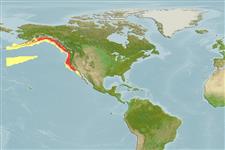>
Perciformes/Zoarcoidei (Eelpouts and pricklebacks) >
Zoarcidae (Eelpouts) > Lycodinae
Etymology: Lycodapus: Greek, lykos = wolf + Greek, oides = similar + Greek, pous = feet.
More on author: Gilbert.
Environment: milieu / climate zone / depth range / distribution range
Écologie
marin bathypélagique; profondeur 100 - 1370 m (Ref. 6885). Deep-water
Eastern Pacific: Prince William Sound in Gulf of Alaska to southern California, USA.
Taille / Poids / Âge
Maturity: Lm ? range ? - ? cm
Max length : 20.0 cm TL mâle / non sexé; (Ref. 2850)
Description synthétique
Clés d'identification | Morphologie | Morphométrie
Épines dorsales (Total) : 0; Rayons mous dorsaux (Total) : 86 - 100; Épines anales: 0; Rayons mous anaux: 77 - 78. Dorsal and anal fins confluent with caudal; caudal fin with narrow tip, bluntly rounded; pectorals small (Ref. 6885). Color almost white, faint speckling of black dots dorsally, more so posteriorly; peritoneum, lining of gill cover, and posterior part of mouth dark (Ref. 6885).
Occurs in midwater, from near surface at night to about 800 m during the day (Ref. 2850).
Life cycle and mating behavior
Maturité | Reproduction | Frai | Œufs | Fécondité | Larves
Anderson, M.E., 1994. Systematics and osteology of the Zoarcidae (Teleostei: Perciformes). Ichthyol. Bull. J.L.B. Smith Inst. Ichthyol. 60:120 p. (Ref. 11954)
Statut dans la liste rouge de l'IUCN (Ref. 130435: Version 2024-2)
Menace pour l'homme
Harmless
Utilisations par l'homme
Pêcheries:
Outils
Articles particuliers
Télécharger en XML
Sources Internet
Estimates based on models
Preferred temperature (Ref.
123201): 3.6 - 6.6, mean 4.8 °C (based on 39 cells).
Phylogenetic diversity index (Ref.
82804): PD
50 = 0.5001 [Uniqueness, from 0.5 = low to 2.0 = high].
Bayesian length-weight: a=0.00120 (0.00058 - 0.00248), b=3.10 (2.91 - 3.29), in cm total length, based on LWR estimates for this (Sub)family-body shape (Ref.
93245).
Niveau trophique (Ref.
69278): 3.3 ±0.4 se; based on size and trophs of closest relatives
Résilience (Ref.
120179): Milieu, temps minimum de doublement de population : 1,4 à 4,4 années (Preliminary K or Fecundity.).
Fishing Vulnerability (Ref.
59153): Low vulnerability (10 of 100).
